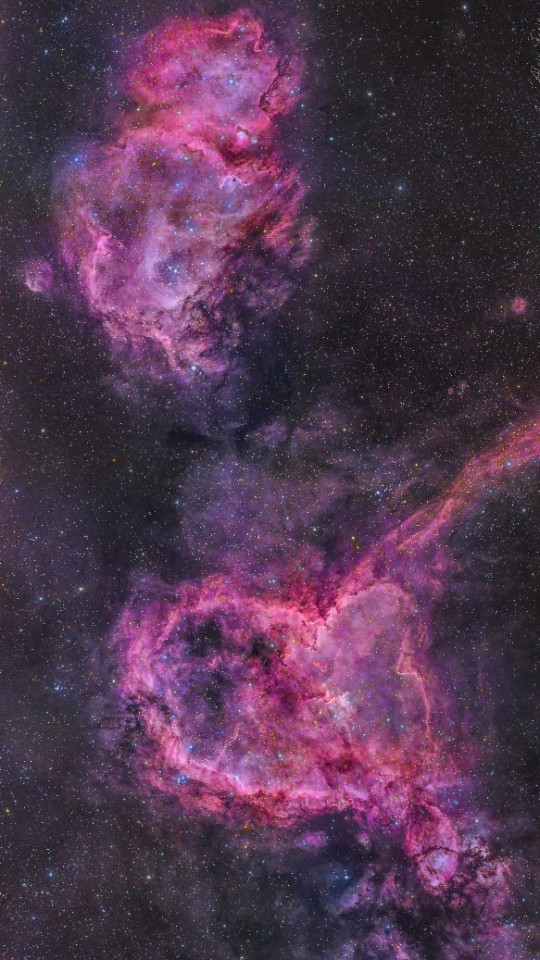Alignment Of The Elements

Alignment of the Elements
calibreus
More Posts from Chbnb and Others

Focus on a small portion of the Milky Way, above Canadian forest, August 2019, showing North American nebula and part the Cygnus constellation. Taken with Nikon D750, 50mm, ISO1600, 10s. I did not have a tripod, it was tricky to keep the camera still.

Milky Way over Canadian Forest, August 2019.
2022 May 29
Simulation TNG50: A Galaxy Cluster Forms Video Credit: IllustrisTNG Project; Visualization: Dylan Nelson (Max Planck Institute for Astrophysics) et al. Music: Symphony No. 5 (Ludwig van Beethoven), via YouTube Audio Library
Explanation: How do clusters of galaxies form? Since our universe moves too slowly to watch, faster-moving computer simulations are created to help find out. A recent effort is TNG50 from IllustrisTNG, an upgrade of the famous Illustris Simulation. The first part of the featured video tracks cosmic gas (mostly hydrogen) as it evolves into galaxies and galaxy clusters from the early universe to today, with brighter colors marking faster moving gas. As the universe matures, gas falls into gravitational wells, galaxies forms, galaxies spin, galaxies collide and merge, all while black holes form in galaxy centers and expel surrounding gas at high speeds. The second half of the video switches to tracking stars, showing a galaxy cluster coming together complete with tidal tails and stellar streams. The outflow from black holes in TNG50 is surprisingly complex and details are being compared with our real universe. Studying how gas coalesced in the early universe helps humanity better understand how our Earth, Sun, and Solar System originally formed.
∞ Source: apod.nasa.gov/apod/ap220529.html


Quiver Tree Forest… Despite the light pollution of neighboring city Keetmanshoop, the Milky Way was bright enough so one can say it’s a bortle 1-2 sky, which is actually the case everywhere in Namibia. (gear in tags, settings and process here )
eg_astrophotography

Milky Way at Darkan, Western Australia
Nikon d5500 - 50mm + Hoya Red Intensifier filter - ISO 3200 - f/2.5 - Foreground: 8 x 13 seconds - Sky: 21 x 30 seconds - iOptron SkyTracker

Clearest image of Phobos ever taken, Moon of Mars





humpback whale series by cam grant

Heart and Soul Nebulae

Bright and cold night sky captured with my good old galaxy S21, from Aosta, Italy. We can see Mars, Orion and the Pléiades.
-
 simply-natalie reblogged this · 2 years ago
simply-natalie reblogged this · 2 years ago -
 arroe reblogged this · 2 years ago
arroe reblogged this · 2 years ago -
 elliegay7 reblogged this · 2 years ago
elliegay7 reblogged this · 2 years ago -
 honestlydecadentstranger liked this · 2 years ago
honestlydecadentstranger liked this · 2 years ago -
 lychnis9 liked this · 2 years ago
lychnis9 liked this · 2 years ago -
 paladinofthelantern reblogged this · 2 years ago
paladinofthelantern reblogged this · 2 years ago -
 paladinofthelantern liked this · 2 years ago
paladinofthelantern liked this · 2 years ago -
 marylove1919 liked this · 2 years ago
marylove1919 liked this · 2 years ago -
 international-network reblogged this · 2 years ago
international-network reblogged this · 2 years ago -
 darccyde liked this · 3 years ago
darccyde liked this · 3 years ago -
 houstonplaguedoctor liked this · 4 years ago
houstonplaguedoctor liked this · 4 years ago -
 nightbringer117 reblogged this · 4 years ago
nightbringer117 reblogged this · 4 years ago -
 nightbringer117 liked this · 4 years ago
nightbringer117 liked this · 4 years ago -
 whyisitfollowthespiders reblogged this · 4 years ago
whyisitfollowthespiders reblogged this · 4 years ago -
 sydnwr liked this · 4 years ago
sydnwr liked this · 4 years ago -
 theabsintheraven reblogged this · 4 years ago
theabsintheraven reblogged this · 4 years ago -
 midnight12-42 reblogged this · 4 years ago
midnight12-42 reblogged this · 4 years ago -
 arcanisluna reblogged this · 4 years ago
arcanisluna reblogged this · 4 years ago -
 mayax81 liked this · 4 years ago
mayax81 liked this · 4 years ago -
 starlight-seraph reblogged this · 4 years ago
starlight-seraph reblogged this · 4 years ago -
 emaretea liked this · 4 years ago
emaretea liked this · 4 years ago -
 bb8-boppity-boo reblogged this · 4 years ago
bb8-boppity-boo reblogged this · 4 years ago -
 otakuinmyblood reblogged this · 5 years ago
otakuinmyblood reblogged this · 5 years ago -
 mirrsd reblogged this · 5 years ago
mirrsd reblogged this · 5 years ago -
 darkestsight reblogged this · 5 years ago
darkestsight reblogged this · 5 years ago -
 shellbelleznatureblog reblogged this · 5 years ago
shellbelleznatureblog reblogged this · 5 years ago -
 angrywinnercolor-blog liked this · 5 years ago
angrywinnercolor-blog liked this · 5 years ago -
 homeroszikacaj reblogged this · 5 years ago
homeroszikacaj reblogged this · 5 years ago -
 shannanigansandmisadventures reblogged this · 5 years ago
shannanigansandmisadventures reblogged this · 5 years ago -
 viveycious reblogged this · 5 years ago
viveycious reblogged this · 5 years ago -
 mossymoonlithearts-blog reblogged this · 5 years ago
mossymoonlithearts-blog reblogged this · 5 years ago -
 tidyphotocollection reblogged this · 5 years ago
tidyphotocollection reblogged this · 5 years ago -
 sagittarivss liked this · 5 years ago
sagittarivss liked this · 5 years ago -
 therealrebehm reblogged this · 5 years ago
therealrebehm reblogged this · 5 years ago -
 technicolor-mage reblogged this · 5 years ago
technicolor-mage reblogged this · 5 years ago -
 angelali2001 liked this · 5 years ago
angelali2001 liked this · 5 years ago -
 kertbet liked this · 5 years ago
kertbet liked this · 5 years ago -
 agplanefan reblogged this · 5 years ago
agplanefan reblogged this · 5 years ago





